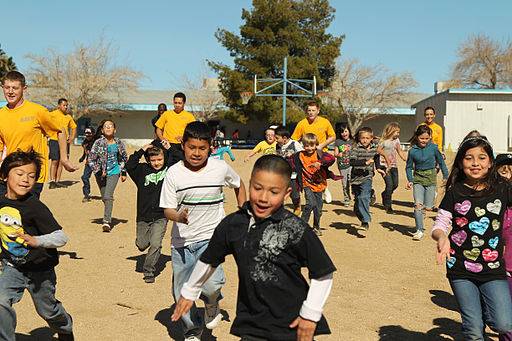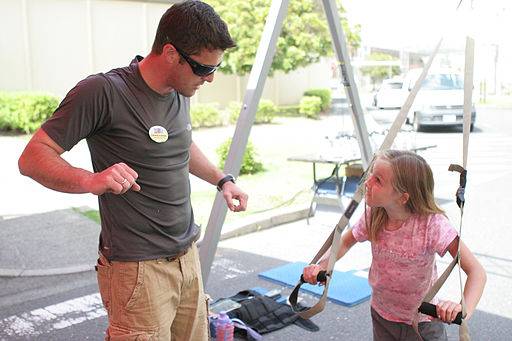According to the Centers For Disease Control and Prevention, the percentage of children in the United States who are obese has tripled in the past thirty years.1 This means there are approximately 13,250,000 obese children in the United States today.
That’s more than the population of 46 states. It’s greater than the population of many countries. Yet, every year, school districts cut funds from physical education (PE) and sports programs. According to one 2010 survey, 61% of PE teachers report that their yearly budget was less than $1000.2
More and more children are growing up uneducated about what it means to be a healthy person. They’re getting heavier and heavier, and becoming ticking time bombs for diabetes, heart attacks, strokes, and other diseases. That’s not even getting into the numerous “minor” health problems, self-image issues, and other conditions that overweight and obese children and adults face.
The overall threat to the United States in terms of lost economic opportunity, money lost through treatment of health issues, and even things like the additional one billion gallons of gas the United States uses transporting obese people around (a cost of about $330 billion dollars) easily adds up to over a trillion dollars annually.3,4
But what can we do about it? Are we to throw our hands up, gnash our teeth, and hope for the best? Move to countries that don’t have such a high percentage of obesity (if so, start learning Japanese, Korean, or Chinese). If this is what you think, please stop reading, and go spend the next few minutes doing something more productive with your time. If you feel that something can be done, that something should be done – then read on.
1. Make Some Noise
Go to your school, talk to the principal and teachers, find out who you need to take your concerns to. This might be the school board, it might be a superintendent, or it might be the city council. Once you find out who to talk to, go talk!
I would recommend not kicking in doors and raising a ruckus (at first). Try to be firmly polite, but make the decision-makers aware that cutting PE is not acceptable, and that PE should be funded and treated with the same level of respect as math, science, and reading.
2. Get Involved

Volunteer at the school. Ask if you can work with the PE teacher (or if your school lacks a PE teacher, then ask about the homeroom teachers) to get activities onto the schedule. This volunteering might be as simple as donating old equipment (balls, bats, or other gear) or as involved (and rewarding) as teaching the activity yourself.
Most schools will jump at free stuff or free teaching, and every teacher I know loves having some assistance. You don’t need to have a teacher’s certification in order to help out. You just need to have the heart to do so.
3. Don’t Give Up – Band Together
What if your school or school district is not receptive to your efforts? You’ve talked, you’ve kicked, you’ve screamed, you’ve volunteered – and you’ve been rebuffed. Don’t give up! Keep making noise, but also put in efforts outside the school system.
Outside the schools, the first thing you can do is band together. You are not the only parent in your town or school who feels the way you do. Network with those other parents. Form a group that can continue to advocate inside the schools, but also gets the kids together outside the schools for physical activity and education. I’m not talking play dates (I still shudder that particular phrase has even come into being), but extracurricular physical activity.
This could be group kids sports, working out, or even just getting everyone together for bike rides in the park. Look around your town, and you might be surprised at how much is out there that could be cheap or free. My only caveat is that if your child tells you he or she would rather do math homework than go do PE with friends in the park, then you’re doing it wrong.
4. Go It Alone
If all else fails of course, you can still go it alone, or go at it as a family. Educate your children on your own, and get them into activities. Find something (anything) they like that is physical in nature.
If your child thinks your CrossFit class is cool, talk to the box owner about children’s groups or classes. If your child loves watching a sport, investigate what it would take to get him or her playing it on the local level. There are numerous advantages to this method.

First of all, you can tailor it to the specific desires and needs of your child, which will greatly increasing interest and chance of continued participation. On the other hand, going it alone can be rather expensive, and in a budget-conscious family this could pose a problem. Educating yourself can help alleviate these costs, but the cost of this option is still most likely going to be higher than any of the others. I personally feel this cost is worth it though, as an investment in my son’s future.
Obesity is not a foregone conclusion for our current generation of children. Additionally, the impact on the United States can still be turned around. Let’s work together, use the strategies I’ve outlined above, and get national fitness back on track.
References:
1. “Childhood Obesity Facts,” Centers for Disease Control and Prevention.
2. “School Physical Education Budgets a Cause for Alarm in New Trends Surveys,” National Association for Sport and Physical Education.
3. Rick Ungar, “Obesity Now Costs Americans More in Healthcare Spending Than Smoking,” Forbes, April 20, 2012.
4. “Petroleum and Other Liquids,” U.S. Energy Information Administration.
Photo 1 by Lance Cpl. D.J. Wu [Public domain], via Wikimedia Commons.
Photos 2 & 3 [Public domain], via Wikimedia Commons.






